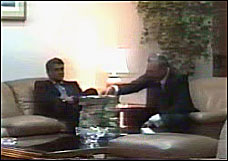Vladimiro Montesinos and the Art of the Bribe
By Jason Felch and Michael Montgomery
Part 1, 2, 3, 4
 | Vladimiro Montesinos (right) counting a stack of money as he bribes a media executive. (left) |
In a government office in Lima, Peru, a hidden camera recorded a secret deal. In the video, two men sit on leather couches trading gossip. One man is dressed in a suit and tie. The other man wears an expensive polo shirt and slacks. He does most of the talking.
"So right now, I hand over the $500,000 in my briefcase, and I'll give you the other $500,000 next Friday," he says.
He starts counting out the money. A pyramid of cash slowly rises on a coffee table.
"$25 plus $25 plus $50 makes $100,000," he says.
This scene might seem familiar. Perhaps it's a government official taking a payoff from a wealthy patron. But in this case the man taking the cash is a Peruvian newspaper owner. And he's being paid by the country's intelligence czar, a man named Vladimiro Montesinos.
It was a scene repeated countless times in Peru during the 10-year presidency of Alberto Fujimori. As Fujimori's spy chief, Montesinos ran much of the Peruvian state in the 1990s. He used vast amounts of embezzled money to bribe judges, politicians, bankers and journalists. Montesinos's network reached far outside Peru, with alleged links to leftist guerrillas in Colombia, international arms dealers, drug traffickers and money launderers.
How much money disappeared in Peru?
Javier Diez Canseco, a Peruvian congressman who led a parliamentary investigation into government corruption in Peru, arrived at a figure of more than $8.5 billion in total losses to the economy.
"It's a very large amount of money what you lose because of corruption and obviously you lose something you cannot repay, which is public trust," says Diez Canseco.
He says the corruption caused widespread damage in Peru. Savings were wiped out when banks deliberately failed. Some hospitals bought expired medicines purchased through kick back schemes. And bids were rigged for public projects.
"This is a tremendous case for learning how corruption can destroy a society," says Peter Eigen, chairman of Transparency International, an independent, anti-corruption group based in Germany. Eigen says the true cost of corruption in Peru, and in other countries, is many times the amount of money actually embezzled.
"The whole essence of paying a bribe is that you want to buy a wrong decision," says Eigen. "A wrong decision about an investment program, a wrong decision about the sizing and timing of a huge project in a country, a wrong decision about the indebtedness of a country and the allocation of scarce resources. Corruption is really the main reason for poverty in these countries and the reason for despair and hopelessness of billions of people who are affected."
Go to Part 2
|



